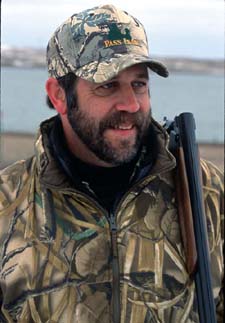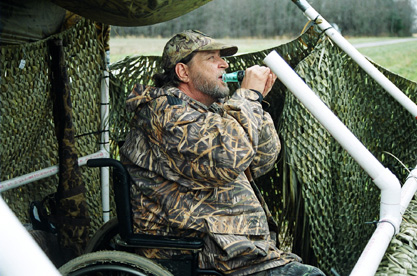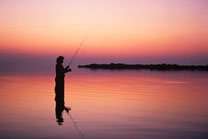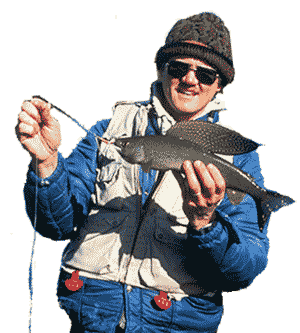
FWS
Director Steve Williams hunting in North Dakota,
FWS Photo by Ryan Hagerty
Director Steve William speaks to the Western Outdoor Writers (October 22, 2004)
Director Steve William speaks to the Southeastern Outdoor Press Association (October 7, 2004)
Director
Williams speaks to the U.S. Sportsmen’s Alliance (September
11, 2004)
Other Speeches
Hunting and Fishing
 Over
the past few years, the Fish and Wildlife Service has made great strides
reaching out to the hunting and fishing community. Through word and deed
we are working to enhance hunting and fishing opportunities and to support
the inherent value to conservation that these activities bring.
Over
the past few years, the Fish and Wildlife Service has made great strides
reaching out to the hunting and fishing community. Through word and deed
we are working to enhance hunting and fishing opportunities and to support
the inherent value to conservation that these activities bring.
In the news.
- FWS explores cooperative conservation in Montana (October 6, 2004
- Director Williams on National Wildlife Refuge Week, October 10-16 (Windows Media format video)
- President Bush proclaims September 25 as National Hunting and Fishing Day. (September 24, 2004)
- President Bush issues executive order to promote local involvement in Federal conservation decisionmaking. (August 26, 2004)
Get involved.
Comprehensive Conservation Plans guide the management of your National Wildlife Refuges, including hunting and fishing opportunities. Learn how you can have a voice in developing plans at a Refuge near you.
Improving hunting and fishing access to federal lands.
- Together with the Bureau
of Land Management, the U.S. Forest
Service, and 17 sportsmen organizations, the Service developed an
agreement that will improve access for hunters and
 anglers
on Federally-managed public lands.
anglers
on Federally-managed public lands. - With the National Wild Turkey Federation's Wheelin' Sportsmen program, we are promoting improved hunting and fishing access for disabled outdoor enthusiasts on National Wildlife Refuges.
- Since 2001, the Service has established more than 60 new hunting and fishing programs on National Wildlife Refuges across the country. With the creation of new hunting and fishing programs on four more refuges and expanded opportunities on seven others, the Service now offers hunting opportunities on 308 refuges and recreational fishing on 270 refuges enhancing access and opportunity for millions of Americans to enjoy their favorite outdoor traditions.
- In 2003, the Service established the first deer management hunt on the grounds of its training center in West Virginia.
Protecting and restoring habitat.
- By the end of the year, the Partners for Fish and Wildlife program will have restored 1.7 million wetland and upland acres, providing valuable habitat for migrating waterfowl and other game and non-game species.
- In Fiscal Years 2004 and
2005, the Coastal Program will
continue to work with more than 300 partners to restore at least 57,000
acres of wetlands and grasslands adding to the more than 900,000 acres
already restored.

- The Fish Passage Program is dedicated to the removal of waterway obstructions that restrict the passage of trout, herring, striped bass, shad, sturgeon, salmon, and other fish species. An additional 91 barriers to fish passage are slated for removal this year.
- Through the Dingell-Johnson Sport Fish Restoration Program (March 2004 Program Update), the Service is distributing more than $260 million to states to support conservation programs in the states as well as boating access. Another $200 million is being distributed to the states for wildlife restoration through the Pittman-Robertson Wildlife Restoration program.
- The North American Wetlands Conservation Program was established in 1989 to provide seed money for the Service and its partners including the state fish and wildlife agencies and important conservation organizations to achieve, in part, the goals of the North American Waterfowl Management Plan. The conservation of important wetland habitat is necessary to ensure healthy populations of waterfowl and other migratory birds. In addition, wetland also serve a critical role by improving water quality and reducing the occurrence of flooding. The Administration requested $54 million for the 2005 fiscal year, an increase of $16.5 million over the amount appropriated for this program in the 2004 fiscal year. For every $1 made available to the Service's state partners, conservation organizations, and private landowners, the public-private partnership program generates another $3 that is used to establish or enhance habitat benefiting waterfowl and many other species, including fish, plants, and non-game wildlife.
Looking ahead.
- Our FY 2005 budget request
illustrates our continued commitment to programs that directly benefit
fish
 and
wildlife and therefore hunters and anglers.
and
wildlife and therefore hunters and anglers. - $54 million for the North American Wetlands Conservation Act, a public-private partnership program used to establish or enhance habitat benefiting waterfowl and other wildlife species.
- $43.3 million for the Migratory Bird Conservation Fund, used to acquire migratory bird breeding, resting, and wintering areas.
- $80 million for State and Tribal Wildlife Grants that provide a new source of income that can be used for non-game management needs, freeing up revenue from hunting and fishing licenses and other sources to be used for game species management.
In order to conserve healthy
wildlife resources, we depend on the support of those who are equally
invested in this goal. Hunters and anglers, who are often called the original
conservationists, are among our greatest partners. Together we can fulfill
the Fish and Wildlife Service's mission to protect and enhance fish, wildlife,
and plants and their habitats for the continuing benefit  of the American
people.
of the American
people.
For more information:
Visit our hunting page
Visit our fishing page
Visit the Department of the Interior page, "Improving Opportunities for Hunters and Anglers"
Visit the Fish and Wildlife Service home page
